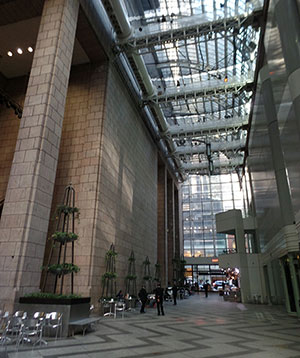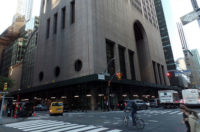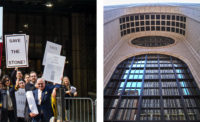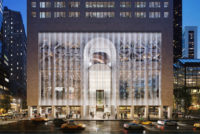Postmodernism may be on the verge of coming of age, but not without a struggle, even for its 1980s poster child, Philip Johnson and John Burgee’s AT&T Building.
As part of the effort, fifty people—albeit with myriad motivations besides architectural history—appeared at a public hearing on Wednesday in New York City to weigh in on whether Johnson and Burgee’s 1984 tower, the former AT&T Building at 550 Madison Avenue, should become an official New York City landmark.
Since Snøhetta’s design proposal was released to the public eight months ago, calling for replacing the rose Stony Creek granite façade with a glass curtain wall, the building has returned to the media spotlight, alternatively basking in the reverie of its admirers, and being freshly criticized by detractors.
Over the course of a nearly two-hour hearing, which was the only opportunity in the LPC process for the public to speak out for or against a building, 31 people gave verbal testimony—all in favor of the former 37-story AT&T Building becoming a landmark. What is still up for debate is whether only the main part of the building’s exterior, or all of it, will be protected.

Photo courtesy Thomas Collins
Though the outcome is not guaranteed, once the LPC deems a building eligible for protected status by adding it to the agency’s calendar, it is rare for commissioners to dismiss it in entirely. Many prominent figures in the profession who support landmark status, such as British architect Richard Rogers, former Museum of Modern Art (MoMA) architecture curator and professor Barry Bergdoll, architect and former MoMA architecture curator Terence Riley, and critic Paul Goldberger contended, however, that some areas of the exterior should be excluded from protection.
As Rogers put it in his testimony, which was read by a representative, the tower itself should be landmarked, but “the rear canopy structure and four-story annex… have no architectural merit.” He recommended that the commission allow a new design to transform the ground-level “without constraining the imagination and functionality by protecting those elements which for decades have dragged the area and building down.”
PKSB Architects principal and former LPC chair and commissioner Sherida Paulsen, who is working for the building owners as a historical adviser and also worked in Johnson and Burgee’s office on the AT&T Building, described the ground-level public spaces as “an awkward compromise” resulting from negotiations with the city so the building could sit right on Madison Avenue.
But preservation organizations, including Docomomo U.S., the Historic Districts Council, and the Municipal Arts Society, advocated for the complete structure, including the annex and atrium, to be declared landmarked elements.
Numerous representatives from the building’s current ownership team, which now includes New York developer RXR Realty in addition to the Saudi conglomerate U.S. arm, Olayan America, unequivocally supported designating the tower’s famous Chippendale top as a landmark, but expressed their hope that the ground floor and annex would be excluded from protected status.
“I think that we can end up with a much better project and a building that has much better public spaces if there’s flexibility,” RXR’s executive vice president Seth Pinsky told Record following the hearing.
RXR is now the lead developer, in partnership with Chelsfield, in repositioning the building, which has been vacant for about two years. Snøhetta is still the project’s main architect, though Pinsky explicitly stated the New York and Oslo-based firm’s design proposal which kickstarted the landmark process was no longer in play.
“The design that was released earlier is no longer the design that we’re working with,” he said.
Still, Pinsky, and nine others affiliated with the project who testified, emphasized the team’s intention to make the ground floor annex and atrium a prominent feature of Snøhetta’s design proposal. It is currently enclosed by glass thanks to the early 1990s renovation of the building by Gwathmey Siegel, into a large garden.
The speakers who echoed Pinsky’s comments at the hearing ranged from the ownership team’s attorney to two different union leaders who said their members will work on the project to the building’s next-door neighbor. MAS’s Tara Kelly called the line-up atypical. “What seems unusual to me is that it was essentially making the case for future plans and not really about the significance of the building itself,” she said.
Pinsky said that RXR, which acquired a minority ownership stake in the project in the spring, did “an enormous amount of outreach,” which led to the large turnout of speakers who supported the ownership team’s stance that the tower’s crown and exterior shaft, but not the rear atrium and annex, should be preserved. The ownership team’s position on the base of the building is not clear.
Commissioners originally discussed the importance of the former AT&T Building’s famed lobby in November, before telling reporters, including RECORD, that LPC would only be considering the exterior of the building for designation. In December, a work permit for “interior demolition” was issued by the Department of Building’s with the LPC’s blessing. Various preservation groups who had been in discussions with the owner’s historical adviser Paulsen and representatives from Olayan America and Chelsfield felt they were were blindsided by discovering that “non bearing partitions and related finishes” were being “partially” removed. Preservationists and a representative from Community Board 5 (CB5) mentioned the demolition as part of their testimony this week.
“We are urging the LPC include the interiors in the scope of their purview so that the proposed new design can be reviewed,” said Layla Law-Gisiko for CB5, noting the developer had agreed to this during conversations with the community board. “We lament the loss of treasured historic fabric, but, short of travelling back in time to right a wrong, let’s make sure that the new lobby is correctly contextual.”
Thomas Collins, a preservationist who filed multiple applications for designation last fall, called the lobby’s demise “a profound lapse of aesthetic judgment,” and said it was “emblematic” of the LPC’s approach to regulating exterior versus interior landmarks.
The LPC’s research staff will now prepare a report, which will include any correspondence from the public in addition to testimony at the hearing. If the LPC decides on landmark status, the terms of the designation, whether it will extend to Johnson and Burgee’s entire building or only certain exterior sections, will be revealed at the public meeting when the vote will take place. The meeting is not yet scheduled.









Post a comment to this article
Report Abusive Comment